False Memory Analysis: HPS203/773 The Human Mind, Deakin University
VerifiedAdded on 2021/06/15
|11
|2864
|53
Report
AI Summary
This report examines the effects of exposure time on false memory using the Deese-Roediger-McDermott (DRM) paradigm. The study involved 306 students from Deakin University, divided into three groups with varying exposure times (fast, medium, and slow) to word lists, followed by a recognition test. Participants were instructed to use visual imagery. The results, analyzed using ANOVA, revealed a significant difference in false memory rates across the groups. The fast exposure group showed significantly higher rates of false memory compared to the medium and slow exposure groups, suggesting that shorter exposure times negatively impact memory recall. The report discusses these findings in relation to existing literature on false memory and visual imagery, highlighting the importance of sufficient processing time for accurate memory formation. The study's limitations and the implications of these findings are also discussed, contributing to a deeper understanding of the neurocognitive underpinnings of memory and its reconstructive nature.
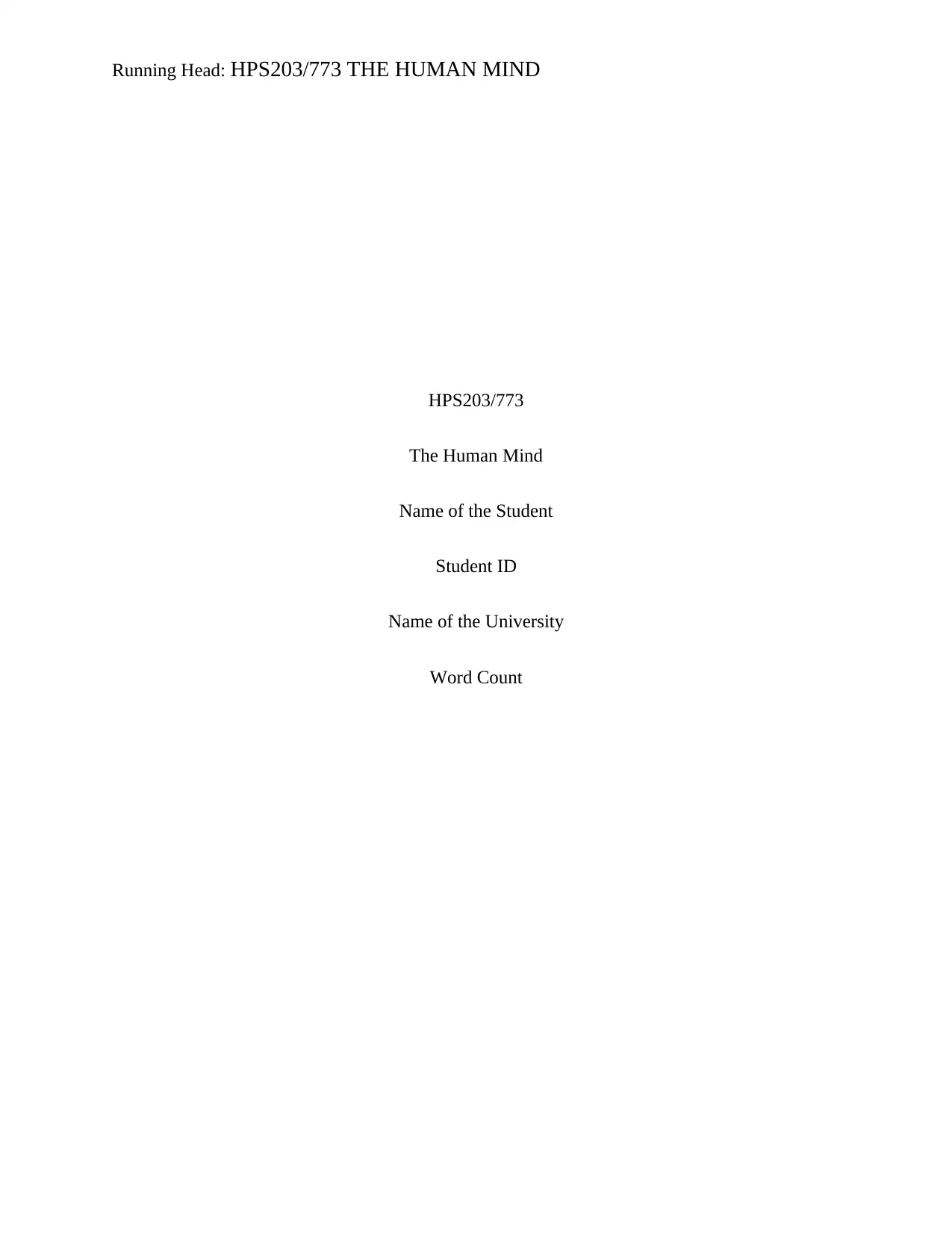
Running Head: HPS203/773 THE HUMAN MIND
HPS203/773
The Human Mind
Name of the Student
Student ID
Name of the University
Word Count
HPS203/773
The Human Mind
Name of the Student
Student ID
Name of the University
Word Count
Paraphrase This Document
Need a fresh take? Get an instant paraphrase of this document with our AI Paraphraser
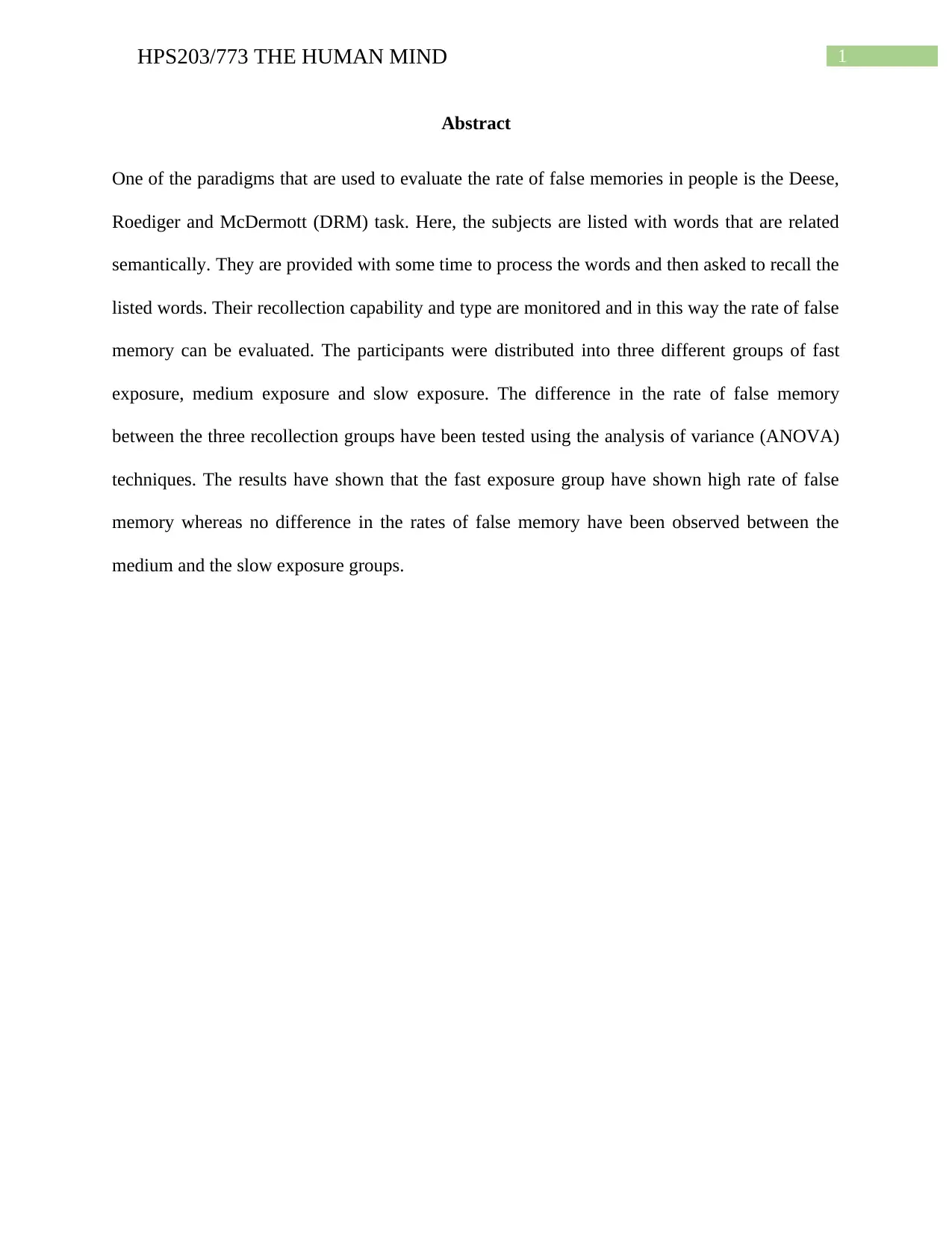
1HPS203/773 THE HUMAN MIND
Abstract
One of the paradigms that are used to evaluate the rate of false memories in people is the Deese,
Roediger and McDermott (DRM) task. Here, the subjects are listed with words that are related
semantically. They are provided with some time to process the words and then asked to recall the
listed words. Their recollection capability and type are monitored and in this way the rate of false
memory can be evaluated. The participants were distributed into three different groups of fast
exposure, medium exposure and slow exposure. The difference in the rate of false memory
between the three recollection groups have been tested using the analysis of variance (ANOVA)
techniques. The results have shown that the fast exposure group have shown high rate of false
memory whereas no difference in the rates of false memory have been observed between the
medium and the slow exposure groups.
Abstract
One of the paradigms that are used to evaluate the rate of false memories in people is the Deese,
Roediger and McDermott (DRM) task. Here, the subjects are listed with words that are related
semantically. They are provided with some time to process the words and then asked to recall the
listed words. Their recollection capability and type are monitored and in this way the rate of false
memory can be evaluated. The participants were distributed into three different groups of fast
exposure, medium exposure and slow exposure. The difference in the rate of false memory
between the three recollection groups have been tested using the analysis of variance (ANOVA)
techniques. The results have shown that the fast exposure group have shown high rate of false
memory whereas no difference in the rates of false memory have been observed between the
medium and the slow exposure groups.
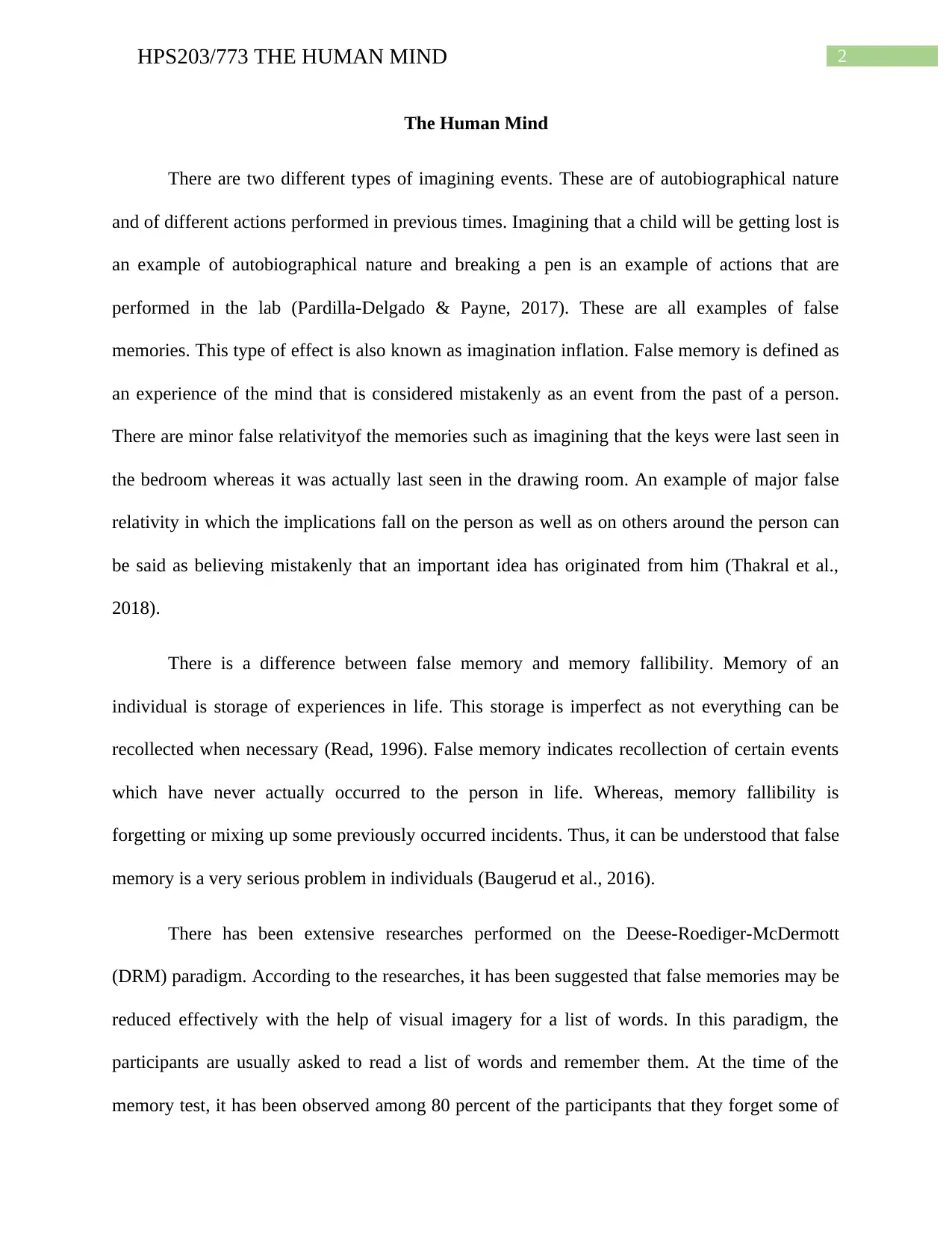
2HPS203/773 THE HUMAN MIND
The Human Mind
There are two different types of imagining events. These are of autobiographical nature
and of different actions performed in previous times. Imagining that a child will be getting lost is
an example of autobiographical nature and breaking a pen is an example of actions that are
performed in the lab (Pardilla-Delgado & Payne, 2017). These are all examples of false
memories. This type of effect is also known as imagination inflation. False memory is defined as
an experience of the mind that is considered mistakenly as an event from the past of a person.
There are minor false relativityof the memories such as imagining that the keys were last seen in
the bedroom whereas it was actually last seen in the drawing room. An example of major false
relativity in which the implications fall on the person as well as on others around the person can
be said as believing mistakenly that an important idea has originated from him (Thakral et al.,
2018).
There is a difference between false memory and memory fallibility. Memory of an
individual is storage of experiences in life. This storage is imperfect as not everything can be
recollected when necessary (Read, 1996). False memory indicates recollection of certain events
which have never actually occurred to the person in life. Whereas, memory fallibility is
forgetting or mixing up some previously occurred incidents. Thus, it can be understood that false
memory is a very serious problem in individuals (Baugerud et al., 2016).
There has been extensive researches performed on the Deese-Roediger-McDermott
(DRM) paradigm. According to the researches, it has been suggested that false memories may be
reduced effectively with the help of visual imagery for a list of words. In this paradigm, the
participants are usually asked to read a list of words and remember them. At the time of the
memory test, it has been observed among 80 percent of the participants that they forget some of
The Human Mind
There are two different types of imagining events. These are of autobiographical nature
and of different actions performed in previous times. Imagining that a child will be getting lost is
an example of autobiographical nature and breaking a pen is an example of actions that are
performed in the lab (Pardilla-Delgado & Payne, 2017). These are all examples of false
memories. This type of effect is also known as imagination inflation. False memory is defined as
an experience of the mind that is considered mistakenly as an event from the past of a person.
There are minor false relativityof the memories such as imagining that the keys were last seen in
the bedroom whereas it was actually last seen in the drawing room. An example of major false
relativity in which the implications fall on the person as well as on others around the person can
be said as believing mistakenly that an important idea has originated from him (Thakral et al.,
2018).
There is a difference between false memory and memory fallibility. Memory of an
individual is storage of experiences in life. This storage is imperfect as not everything can be
recollected when necessary (Read, 1996). False memory indicates recollection of certain events
which have never actually occurred to the person in life. Whereas, memory fallibility is
forgetting or mixing up some previously occurred incidents. Thus, it can be understood that false
memory is a very serious problem in individuals (Baugerud et al., 2016).
There has been extensive researches performed on the Deese-Roediger-McDermott
(DRM) paradigm. According to the researches, it has been suggested that false memories may be
reduced effectively with the help of visual imagery for a list of words. In this paradigm, the
participants are usually asked to read a list of words and remember them. At the time of the
memory test, it has been observed among 80 percent of the participants that they forget some of
⊘ This is a preview!⊘
Do you want full access?
Subscribe today to unlock all pages.

Trusted by 1+ million students worldwide
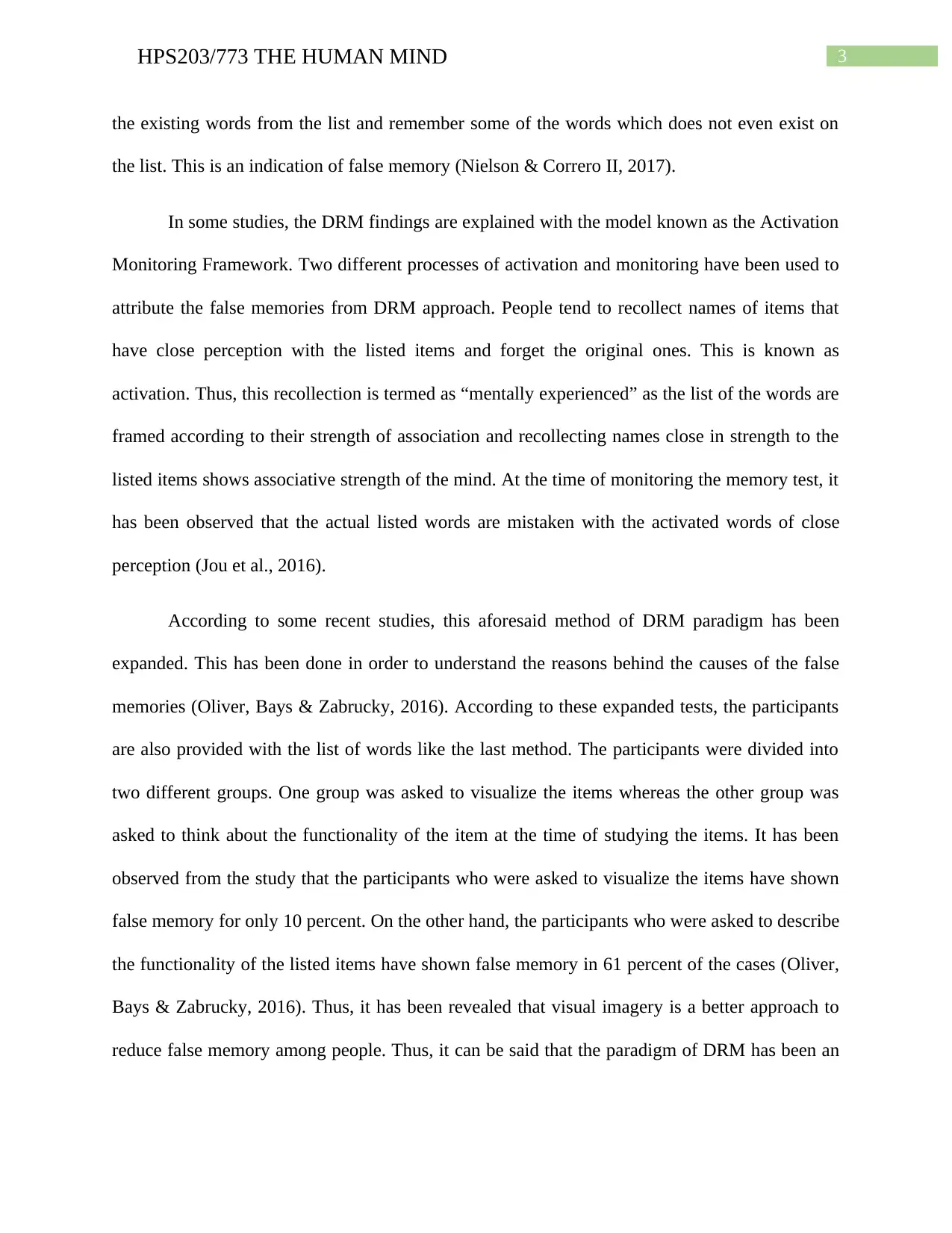
3HPS203/773 THE HUMAN MIND
the existing words from the list and remember some of the words which does not even exist on
the list. This is an indication of false memory (Nielson & Correro II, 2017).
In some studies, the DRM findings are explained with the model known as the Activation
Monitoring Framework. Two different processes of activation and monitoring have been used to
attribute the false memories from DRM approach. People tend to recollect names of items that
have close perception with the listed items and forget the original ones. This is known as
activation. Thus, this recollection is termed as “mentally experienced” as the list of the words are
framed according to their strength of association and recollecting names close in strength to the
listed items shows associative strength of the mind. At the time of monitoring the memory test, it
has been observed that the actual listed words are mistaken with the activated words of close
perception (Jou et al., 2016).
According to some recent studies, this aforesaid method of DRM paradigm has been
expanded. This has been done in order to understand the reasons behind the causes of the false
memories (Oliver, Bays & Zabrucky, 2016). According to these expanded tests, the participants
are also provided with the list of words like the last method. The participants were divided into
two different groups. One group was asked to visualize the items whereas the other group was
asked to think about the functionality of the item at the time of studying the items. It has been
observed from the study that the participants who were asked to visualize the items have shown
false memory for only 10 percent. On the other hand, the participants who were asked to describe
the functionality of the listed items have shown false memory in 61 percent of the cases (Oliver,
Bays & Zabrucky, 2016). Thus, it has been revealed that visual imagery is a better approach to
reduce false memory among people. Thus, it can be said that the paradigm of DRM has been an
the existing words from the list and remember some of the words which does not even exist on
the list. This is an indication of false memory (Nielson & Correro II, 2017).
In some studies, the DRM findings are explained with the model known as the Activation
Monitoring Framework. Two different processes of activation and monitoring have been used to
attribute the false memories from DRM approach. People tend to recollect names of items that
have close perception with the listed items and forget the original ones. This is known as
activation. Thus, this recollection is termed as “mentally experienced” as the list of the words are
framed according to their strength of association and recollecting names close in strength to the
listed items shows associative strength of the mind. At the time of monitoring the memory test, it
has been observed that the actual listed words are mistaken with the activated words of close
perception (Jou et al., 2016).
According to some recent studies, this aforesaid method of DRM paradigm has been
expanded. This has been done in order to understand the reasons behind the causes of the false
memories (Oliver, Bays & Zabrucky, 2016). According to these expanded tests, the participants
are also provided with the list of words like the last method. The participants were divided into
two different groups. One group was asked to visualize the items whereas the other group was
asked to think about the functionality of the item at the time of studying the items. It has been
observed from the study that the participants who were asked to visualize the items have shown
false memory for only 10 percent. On the other hand, the participants who were asked to describe
the functionality of the listed items have shown false memory in 61 percent of the cases (Oliver,
Bays & Zabrucky, 2016). Thus, it has been revealed that visual imagery is a better approach to
reduce false memory among people. Thus, it can be said that the paradigm of DRM has been an
Paraphrase This Document
Need a fresh take? Get an instant paraphrase of this document with our AI Paraphraser
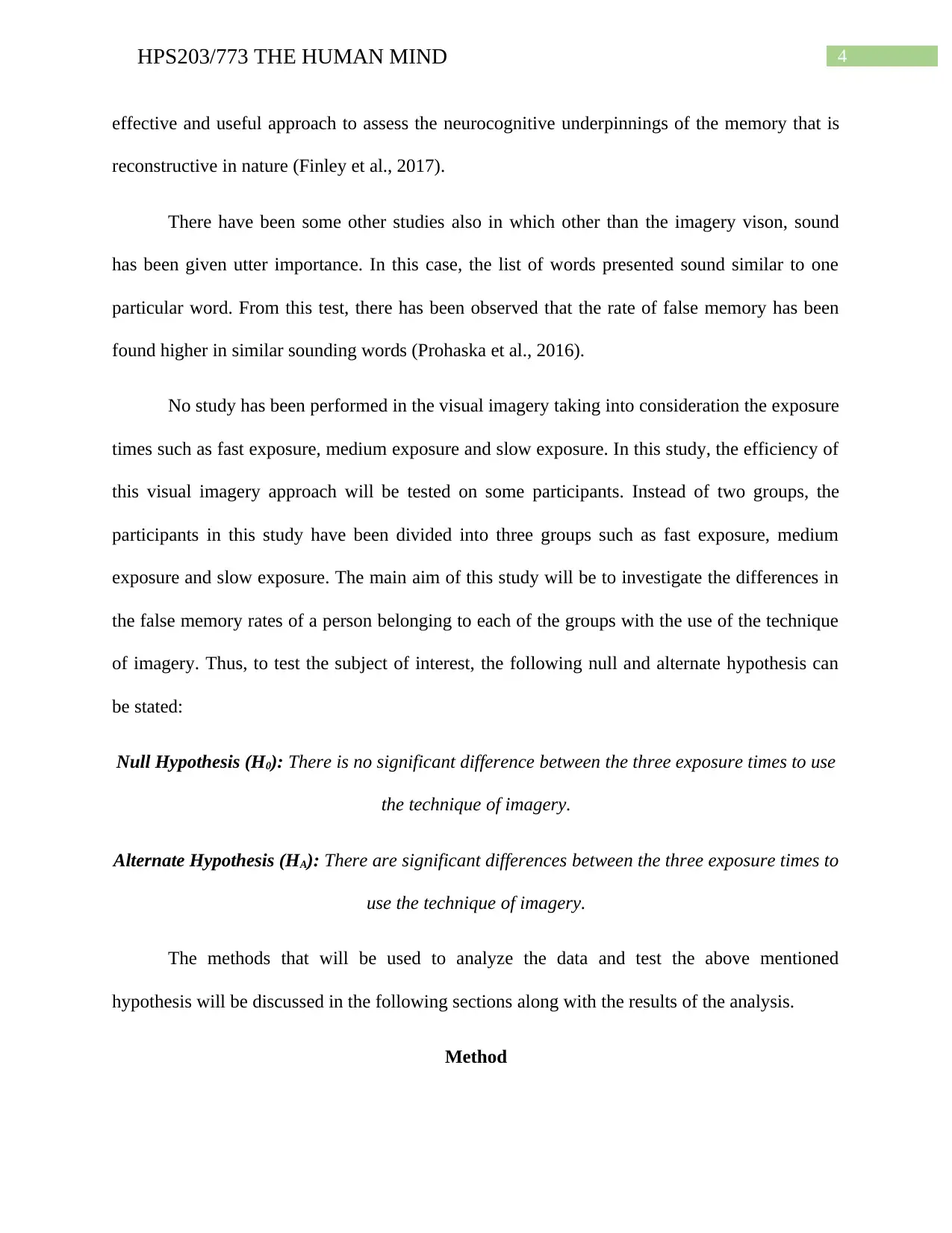
4HPS203/773 THE HUMAN MIND
effective and useful approach to assess the neurocognitive underpinnings of the memory that is
reconstructive in nature (Finley et al., 2017).
There have been some other studies also in which other than the imagery vison, sound
has been given utter importance. In this case, the list of words presented sound similar to one
particular word. From this test, there has been observed that the rate of false memory has been
found higher in similar sounding words (Prohaska et al., 2016).
No study has been performed in the visual imagery taking into consideration the exposure
times such as fast exposure, medium exposure and slow exposure. In this study, the efficiency of
this visual imagery approach will be tested on some participants. Instead of two groups, the
participants in this study have been divided into three groups such as fast exposure, medium
exposure and slow exposure. The main aim of this study will be to investigate the differences in
the false memory rates of a person belonging to each of the groups with the use of the technique
of imagery. Thus, to test the subject of interest, the following null and alternate hypothesis can
be stated:
Null Hypothesis (H0): There is no significant difference between the three exposure times to use
the technique of imagery.
Alternate Hypothesis (HA): There are significant differences between the three exposure times to
use the technique of imagery.
The methods that will be used to analyze the data and test the above mentioned
hypothesis will be discussed in the following sections along with the results of the analysis.
Method
effective and useful approach to assess the neurocognitive underpinnings of the memory that is
reconstructive in nature (Finley et al., 2017).
There have been some other studies also in which other than the imagery vison, sound
has been given utter importance. In this case, the list of words presented sound similar to one
particular word. From this test, there has been observed that the rate of false memory has been
found higher in similar sounding words (Prohaska et al., 2016).
No study has been performed in the visual imagery taking into consideration the exposure
times such as fast exposure, medium exposure and slow exposure. In this study, the efficiency of
this visual imagery approach will be tested on some participants. Instead of two groups, the
participants in this study have been divided into three groups such as fast exposure, medium
exposure and slow exposure. The main aim of this study will be to investigate the differences in
the false memory rates of a person belonging to each of the groups with the use of the technique
of imagery. Thus, to test the subject of interest, the following null and alternate hypothesis can
be stated:
Null Hypothesis (H0): There is no significant difference between the three exposure times to use
the technique of imagery.
Alternate Hypothesis (HA): There are significant differences between the three exposure times to
use the technique of imagery.
The methods that will be used to analyze the data and test the above mentioned
hypothesis will be discussed in the following sections along with the results of the analysis.
Method
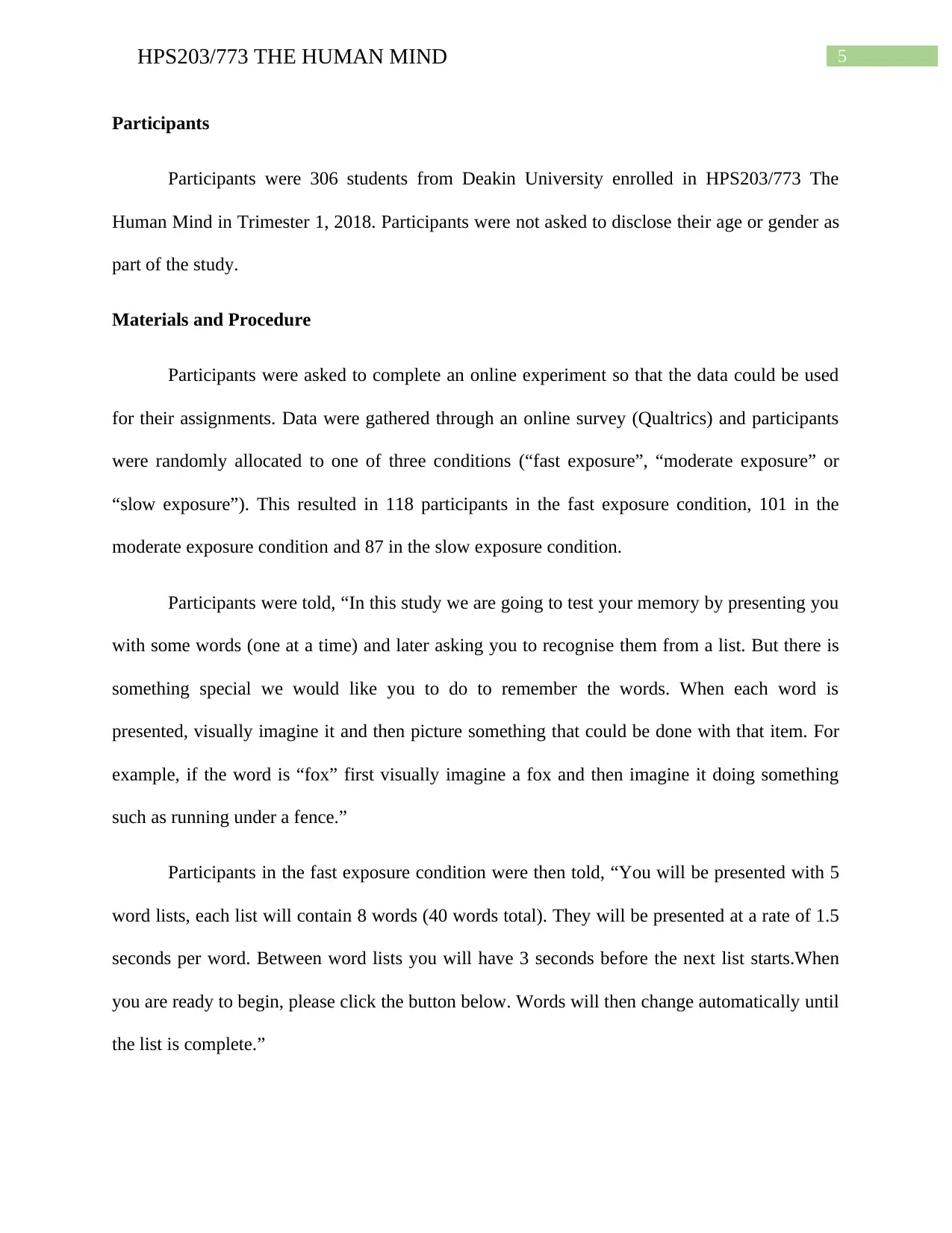
5HPS203/773 THE HUMAN MIND
Participants
Participants were 306 students from Deakin University enrolled in HPS203/773 The
Human Mind in Trimester 1, 2018. Participants were not asked to disclose their age or gender as
part of the study.
Materials and Procedure
Participants were asked to complete an online experiment so that the data could be used
for their assignments. Data were gathered through an online survey (Qualtrics) and participants
were randomly allocated to one of three conditions (“fast exposure”, “moderate exposure” or
“slow exposure”). This resulted in 118 participants in the fast exposure condition, 101 in the
moderate exposure condition and 87 in the slow exposure condition.
Participants were told, “In this study we are going to test your memory by presenting you
with some words (one at a time) and later asking you to recognise them from a list. But there is
something special we would like you to do to remember the words. When each word is
presented, visually imagine it and then picture something that could be done with that item. For
example, if the word is “fox” first visually imagine a fox and then imagine it doing something
such as running under a fence.”
Participants in the fast exposure condition were then told, “You will be presented with 5
word lists, each list will contain 8 words (40 words total). They will be presented at a rate of 1.5
seconds per word. Between word lists you will have 3 seconds before the next list starts.When
you are ready to begin, please click the button below. Words will then change automatically until
the list is complete.”
Participants
Participants were 306 students from Deakin University enrolled in HPS203/773 The
Human Mind in Trimester 1, 2018. Participants were not asked to disclose their age or gender as
part of the study.
Materials and Procedure
Participants were asked to complete an online experiment so that the data could be used
for their assignments. Data were gathered through an online survey (Qualtrics) and participants
were randomly allocated to one of three conditions (“fast exposure”, “moderate exposure” or
“slow exposure”). This resulted in 118 participants in the fast exposure condition, 101 in the
moderate exposure condition and 87 in the slow exposure condition.
Participants were told, “In this study we are going to test your memory by presenting you
with some words (one at a time) and later asking you to recognise them from a list. But there is
something special we would like you to do to remember the words. When each word is
presented, visually imagine it and then picture something that could be done with that item. For
example, if the word is “fox” first visually imagine a fox and then imagine it doing something
such as running under a fence.”
Participants in the fast exposure condition were then told, “You will be presented with 5
word lists, each list will contain 8 words (40 words total). They will be presented at a rate of 1.5
seconds per word. Between word lists you will have 3 seconds before the next list starts.When
you are ready to begin, please click the button below. Words will then change automatically until
the list is complete.”
⊘ This is a preview!⊘
Do you want full access?
Subscribe today to unlock all pages.

Trusted by 1+ million students worldwide
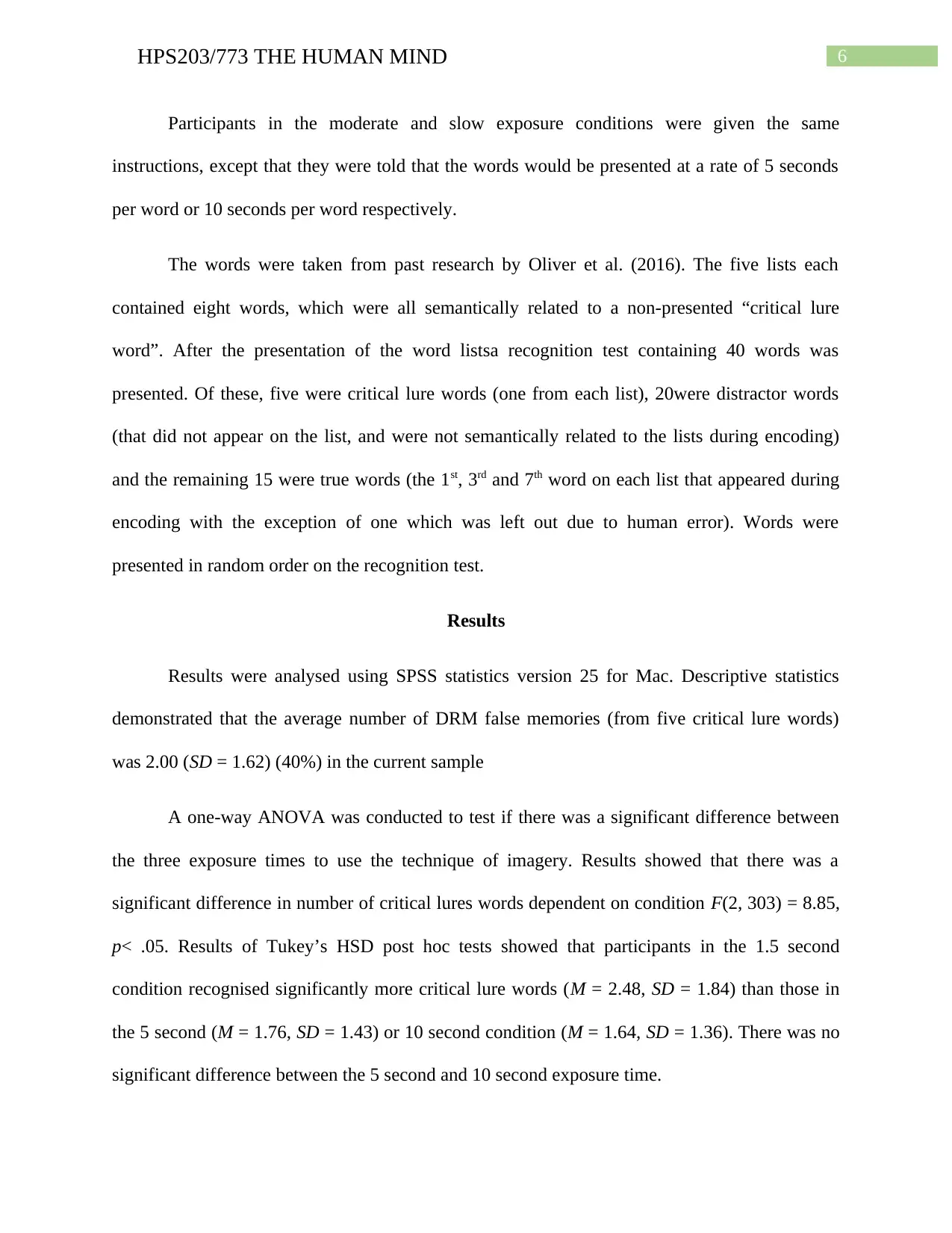
6HPS203/773 THE HUMAN MIND
Participants in the moderate and slow exposure conditions were given the same
instructions, except that they were told that the words would be presented at a rate of 5 seconds
per word or 10 seconds per word respectively.
The words were taken from past research by Oliver et al. (2016). The five lists each
contained eight words, which were all semantically related to a non-presented “critical lure
word”. After the presentation of the word listsa recognition test containing 40 words was
presented. Of these, five were critical lure words (one from each list), 20were distractor words
(that did not appear on the list, and were not semantically related to the lists during encoding)
and the remaining 15 were true words (the 1st, 3rd and 7th word on each list that appeared during
encoding with the exception of one which was left out due to human error). Words were
presented in random order on the recognition test.
Results
Results were analysed using SPSS statistics version 25 for Mac. Descriptive statistics
demonstrated that the average number of DRM false memories (from five critical lure words)
was 2.00 (SD = 1.62) (40%) in the current sample
A one-way ANOVA was conducted to test if there was a significant difference between
the three exposure times to use the technique of imagery. Results showed that there was a
significant difference in number of critical lures words dependent on condition F(2, 303) = 8.85,
p< .05. Results of Tukey’s HSD post hoc tests showed that participants in the 1.5 second
condition recognised significantly more critical lure words (M = 2.48, SD = 1.84) than those in
the 5 second (M = 1.76, SD = 1.43) or 10 second condition (M = 1.64, SD = 1.36). There was no
significant difference between the 5 second and 10 second exposure time.
Participants in the moderate and slow exposure conditions were given the same
instructions, except that they were told that the words would be presented at a rate of 5 seconds
per word or 10 seconds per word respectively.
The words were taken from past research by Oliver et al. (2016). The five lists each
contained eight words, which were all semantically related to a non-presented “critical lure
word”. After the presentation of the word listsa recognition test containing 40 words was
presented. Of these, five were critical lure words (one from each list), 20were distractor words
(that did not appear on the list, and were not semantically related to the lists during encoding)
and the remaining 15 were true words (the 1st, 3rd and 7th word on each list that appeared during
encoding with the exception of one which was left out due to human error). Words were
presented in random order on the recognition test.
Results
Results were analysed using SPSS statistics version 25 for Mac. Descriptive statistics
demonstrated that the average number of DRM false memories (from five critical lure words)
was 2.00 (SD = 1.62) (40%) in the current sample
A one-way ANOVA was conducted to test if there was a significant difference between
the three exposure times to use the technique of imagery. Results showed that there was a
significant difference in number of critical lures words dependent on condition F(2, 303) = 8.85,
p< .05. Results of Tukey’s HSD post hoc tests showed that participants in the 1.5 second
condition recognised significantly more critical lure words (M = 2.48, SD = 1.84) than those in
the 5 second (M = 1.76, SD = 1.43) or 10 second condition (M = 1.64, SD = 1.36). There was no
significant difference between the 5 second and 10 second exposure time.
Paraphrase This Document
Need a fresh take? Get an instant paraphrase of this document with our AI Paraphraser
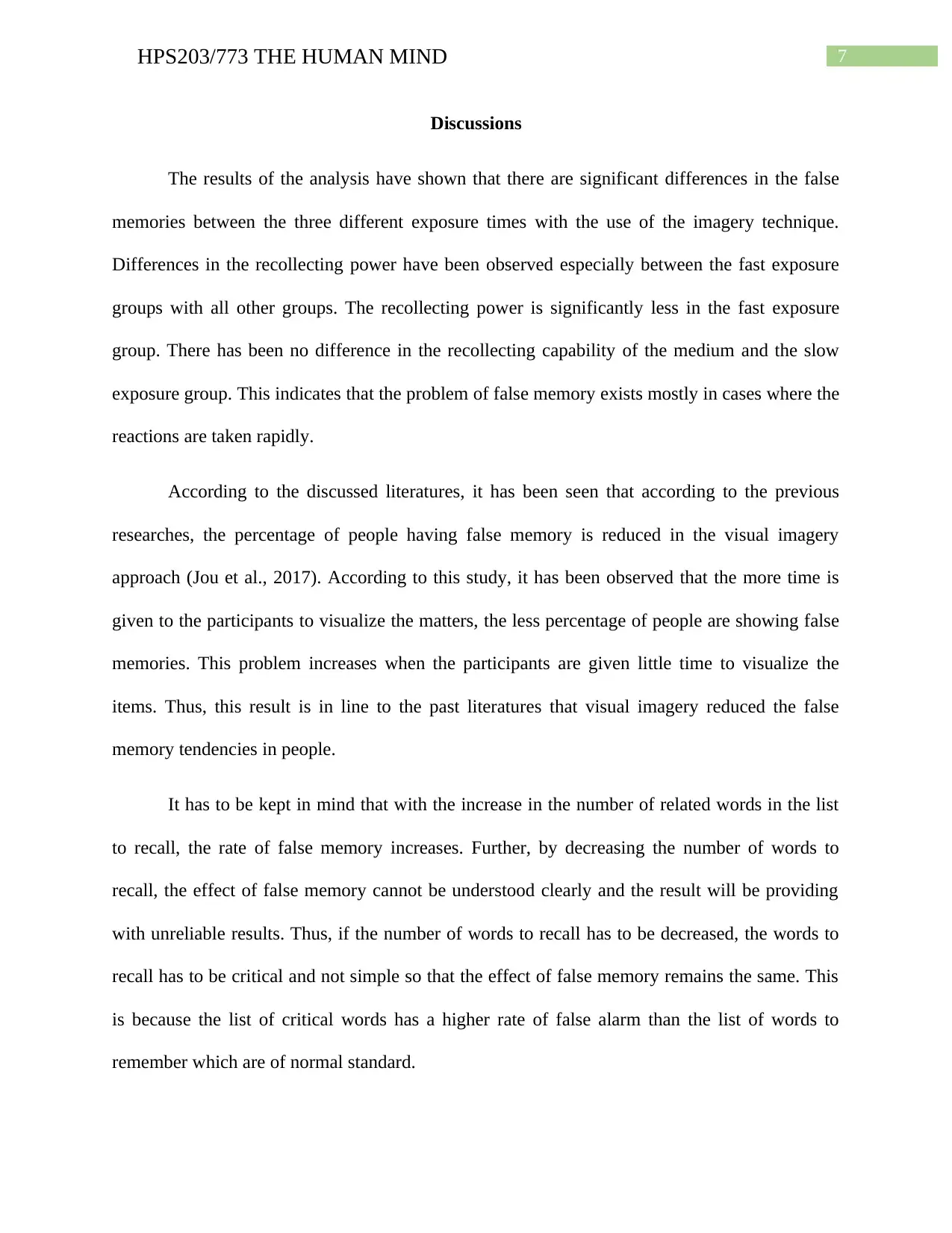
7HPS203/773 THE HUMAN MIND
Discussions
The results of the analysis have shown that there are significant differences in the false
memories between the three different exposure times with the use of the imagery technique.
Differences in the recollecting power have been observed especially between the fast exposure
groups with all other groups. The recollecting power is significantly less in the fast exposure
group. There has been no difference in the recollecting capability of the medium and the slow
exposure group. This indicates that the problem of false memory exists mostly in cases where the
reactions are taken rapidly.
According to the discussed literatures, it has been seen that according to the previous
researches, the percentage of people having false memory is reduced in the visual imagery
approach (Jou et al., 2017). According to this study, it has been observed that the more time is
given to the participants to visualize the matters, the less percentage of people are showing false
memories. This problem increases when the participants are given little time to visualize the
items. Thus, this result is in line to the past literatures that visual imagery reduced the false
memory tendencies in people.
It has to be kept in mind that with the increase in the number of related words in the list
to recall, the rate of false memory increases. Further, by decreasing the number of words to
recall, the effect of false memory cannot be understood clearly and the result will be providing
with unreliable results. Thus, if the number of words to recall has to be decreased, the words to
recall has to be critical and not simple so that the effect of false memory remains the same. This
is because the list of critical words has a higher rate of false alarm than the list of words to
remember which are of normal standard.
Discussions
The results of the analysis have shown that there are significant differences in the false
memories between the three different exposure times with the use of the imagery technique.
Differences in the recollecting power have been observed especially between the fast exposure
groups with all other groups. The recollecting power is significantly less in the fast exposure
group. There has been no difference in the recollecting capability of the medium and the slow
exposure group. This indicates that the problem of false memory exists mostly in cases where the
reactions are taken rapidly.
According to the discussed literatures, it has been seen that according to the previous
researches, the percentage of people having false memory is reduced in the visual imagery
approach (Jou et al., 2017). According to this study, it has been observed that the more time is
given to the participants to visualize the matters, the less percentage of people are showing false
memories. This problem increases when the participants are given little time to visualize the
items. Thus, this result is in line to the past literatures that visual imagery reduced the false
memory tendencies in people.
It has to be kept in mind that with the increase in the number of related words in the list
to recall, the rate of false memory increases. Further, by decreasing the number of words to
recall, the effect of false memory cannot be understood clearly and the result will be providing
with unreliable results. Thus, if the number of words to recall has to be decreased, the words to
recall has to be critical and not simple so that the effect of false memory remains the same. This
is because the list of critical words has a higher rate of false alarm than the list of words to
remember which are of normal standard.
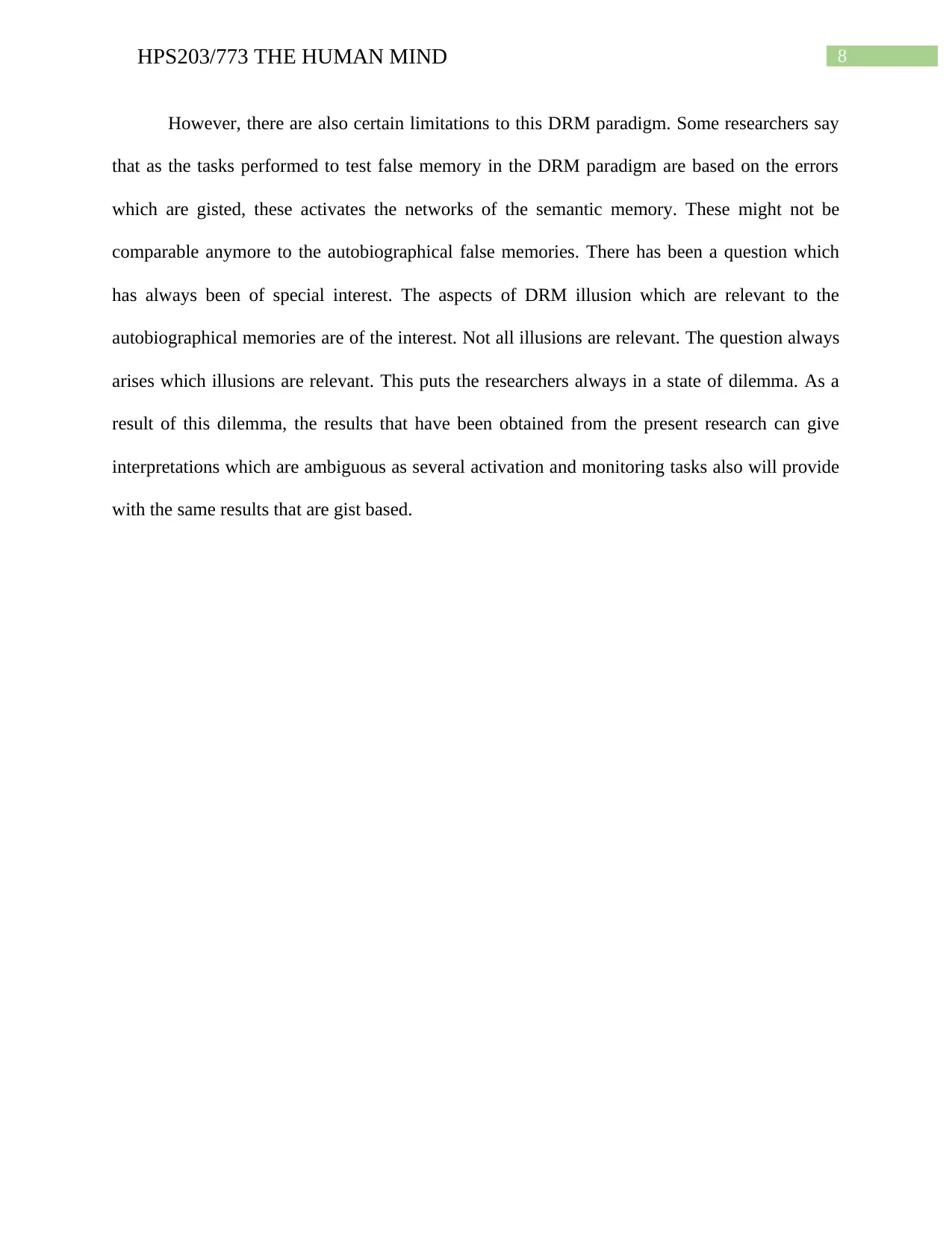
8HPS203/773 THE HUMAN MIND
However, there are also certain limitations to this DRM paradigm. Some researchers say
that as the tasks performed to test false memory in the DRM paradigm are based on the errors
which are gisted, these activates the networks of the semantic memory. These might not be
comparable anymore to the autobiographical false memories. There has been a question which
has always been of special interest. The aspects of DRM illusion which are relevant to the
autobiographical memories are of the interest. Not all illusions are relevant. The question always
arises which illusions are relevant. This puts the researchers always in a state of dilemma. As a
result of this dilemma, the results that have been obtained from the present research can give
interpretations which are ambiguous as several activation and monitoring tasks also will provide
with the same results that are gist based.
However, there are also certain limitations to this DRM paradigm. Some researchers say
that as the tasks performed to test false memory in the DRM paradigm are based on the errors
which are gisted, these activates the networks of the semantic memory. These might not be
comparable anymore to the autobiographical false memories. There has been a question which
has always been of special interest. The aspects of DRM illusion which are relevant to the
autobiographical memories are of the interest. Not all illusions are relevant. The question always
arises which illusions are relevant. This puts the researchers always in a state of dilemma. As a
result of this dilemma, the results that have been obtained from the present research can give
interpretations which are ambiguous as several activation and monitoring tasks also will provide
with the same results that are gist based.
⊘ This is a preview!⊘
Do you want full access?
Subscribe today to unlock all pages.

Trusted by 1+ million students worldwide
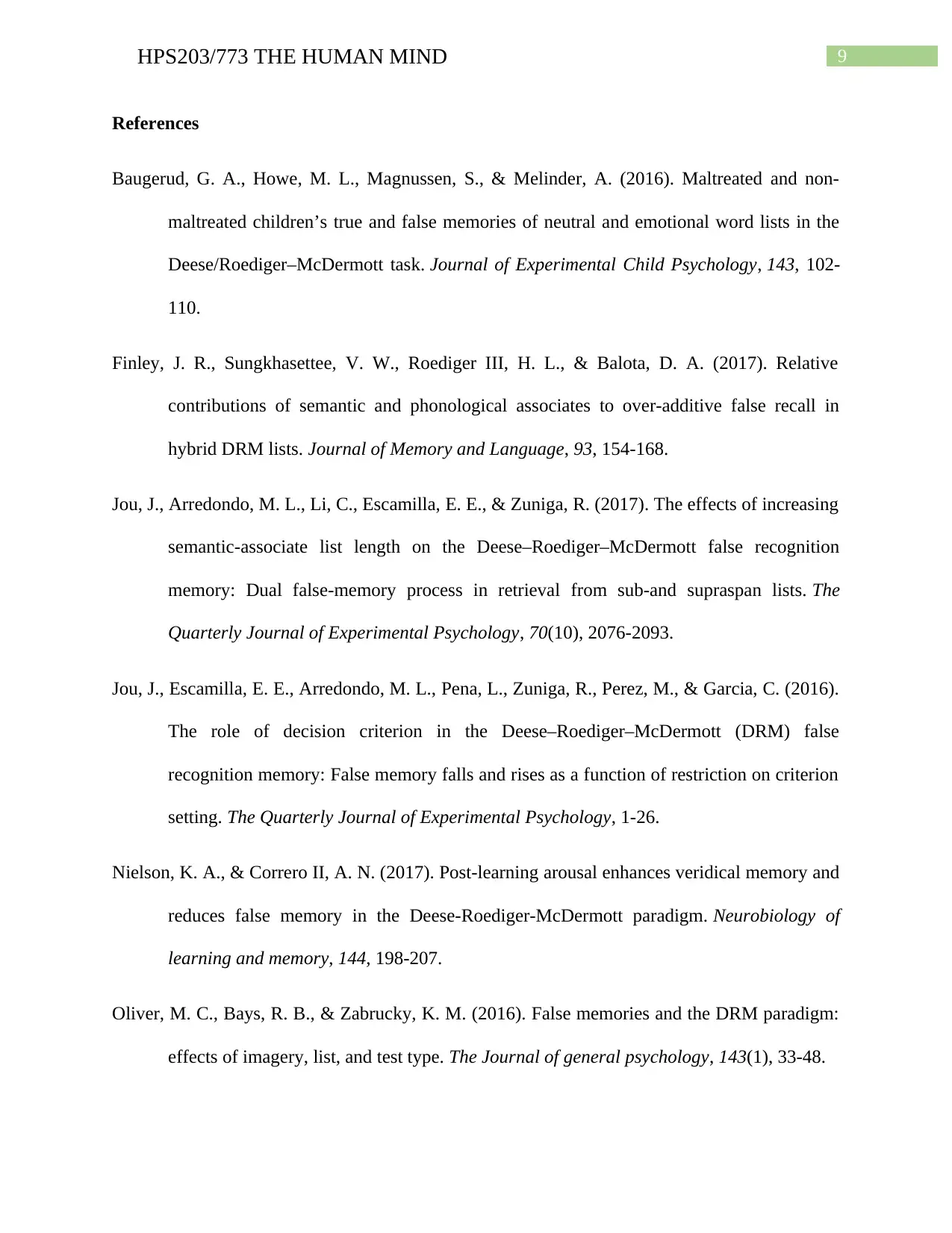
9HPS203/773 THE HUMAN MIND
References
Baugerud, G. A., Howe, M. L., Magnussen, S., & Melinder, A. (2016). Maltreated and non-
maltreated children’s true and false memories of neutral and emotional word lists in the
Deese/Roediger–McDermott task. Journal of Experimental Child Psychology, 143, 102-
110.
Finley, J. R., Sungkhasettee, V. W., Roediger III, H. L., & Balota, D. A. (2017). Relative
contributions of semantic and phonological associates to over-additive false recall in
hybrid DRM lists. Journal of Memory and Language, 93, 154-168.
Jou, J., Arredondo, M. L., Li, C., Escamilla, E. E., & Zuniga, R. (2017). The effects of increasing
semantic-associate list length on the Deese–Roediger–McDermott false recognition
memory: Dual false-memory process in retrieval from sub-and supraspan lists. The
Quarterly Journal of Experimental Psychology, 70(10), 2076-2093.
Jou, J., Escamilla, E. E., Arredondo, M. L., Pena, L., Zuniga, R., Perez, M., & Garcia, C. (2016).
The role of decision criterion in the Deese–Roediger–McDermott (DRM) false
recognition memory: False memory falls and rises as a function of restriction on criterion
setting. The Quarterly Journal of Experimental Psychology, 1-26.
Nielson, K. A., & Correro II, A. N. (2017). Post-learning arousal enhances veridical memory and
reduces false memory in the Deese-Roediger-McDermott paradigm. Neurobiology of
learning and memory, 144, 198-207.
Oliver, M. C., Bays, R. B., & Zabrucky, K. M. (2016). False memories and the DRM paradigm:
effects of imagery, list, and test type. The Journal of general psychology, 143(1), 33-48.
References
Baugerud, G. A., Howe, M. L., Magnussen, S., & Melinder, A. (2016). Maltreated and non-
maltreated children’s true and false memories of neutral and emotional word lists in the
Deese/Roediger–McDermott task. Journal of Experimental Child Psychology, 143, 102-
110.
Finley, J. R., Sungkhasettee, V. W., Roediger III, H. L., & Balota, D. A. (2017). Relative
contributions of semantic and phonological associates to over-additive false recall in
hybrid DRM lists. Journal of Memory and Language, 93, 154-168.
Jou, J., Arredondo, M. L., Li, C., Escamilla, E. E., & Zuniga, R. (2017). The effects of increasing
semantic-associate list length on the Deese–Roediger–McDermott false recognition
memory: Dual false-memory process in retrieval from sub-and supraspan lists. The
Quarterly Journal of Experimental Psychology, 70(10), 2076-2093.
Jou, J., Escamilla, E. E., Arredondo, M. L., Pena, L., Zuniga, R., Perez, M., & Garcia, C. (2016).
The role of decision criterion in the Deese–Roediger–McDermott (DRM) false
recognition memory: False memory falls and rises as a function of restriction on criterion
setting. The Quarterly Journal of Experimental Psychology, 1-26.
Nielson, K. A., & Correro II, A. N. (2017). Post-learning arousal enhances veridical memory and
reduces false memory in the Deese-Roediger-McDermott paradigm. Neurobiology of
learning and memory, 144, 198-207.
Oliver, M. C., Bays, R. B., & Zabrucky, K. M. (2016). False memories and the DRM paradigm:
effects of imagery, list, and test type. The Journal of general psychology, 143(1), 33-48.
Paraphrase This Document
Need a fresh take? Get an instant paraphrase of this document with our AI Paraphraser
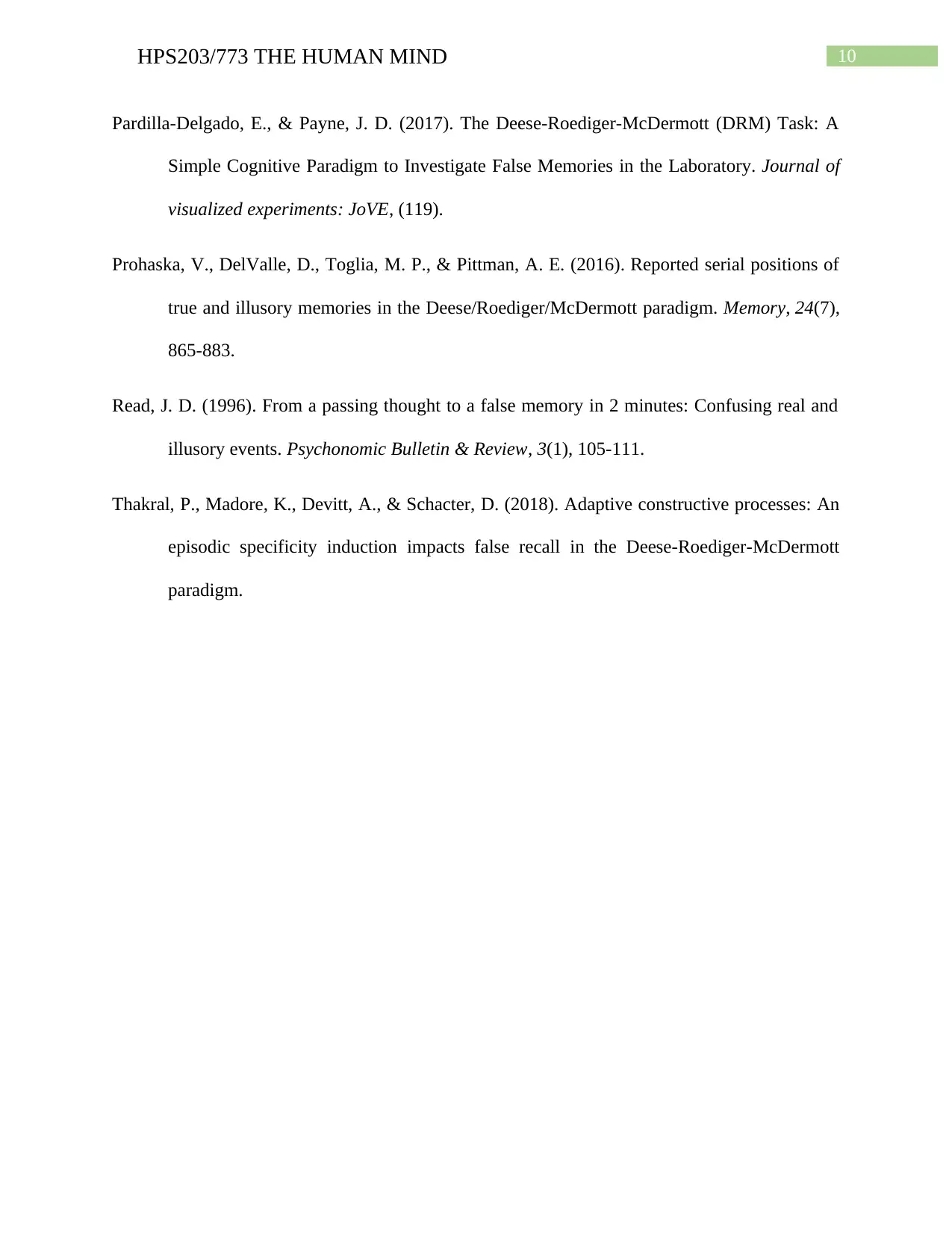
10HPS203/773 THE HUMAN MIND
Pardilla-Delgado, E., & Payne, J. D. (2017). The Deese-Roediger-McDermott (DRM) Task: A
Simple Cognitive Paradigm to Investigate False Memories in the Laboratory. Journal of
visualized experiments: JoVE, (119).
Prohaska, V., DelValle, D., Toglia, M. P., & Pittman, A. E. (2016). Reported serial positions of
true and illusory memories in the Deese/Roediger/McDermott paradigm. Memory, 24(7),
865-883.
Read, J. D. (1996). From a passing thought to a false memory in 2 minutes: Confusing real and
illusory events. Psychonomic Bulletin & Review, 3(1), 105-111.
Thakral, P., Madore, K., Devitt, A., & Schacter, D. (2018). Adaptive constructive processes: An
episodic specificity induction impacts false recall in the Deese-Roediger-McDermott
paradigm.
Pardilla-Delgado, E., & Payne, J. D. (2017). The Deese-Roediger-McDermott (DRM) Task: A
Simple Cognitive Paradigm to Investigate False Memories in the Laboratory. Journal of
visualized experiments: JoVE, (119).
Prohaska, V., DelValle, D., Toglia, M. P., & Pittman, A. E. (2016). Reported serial positions of
true and illusory memories in the Deese/Roediger/McDermott paradigm. Memory, 24(7),
865-883.
Read, J. D. (1996). From a passing thought to a false memory in 2 minutes: Confusing real and
illusory events. Psychonomic Bulletin & Review, 3(1), 105-111.
Thakral, P., Madore, K., Devitt, A., & Schacter, D. (2018). Adaptive constructive processes: An
episodic specificity induction impacts false recall in the Deese-Roediger-McDermott
paradigm.
1 out of 11
Your All-in-One AI-Powered Toolkit for Academic Success.
+13062052269
info@desklib.com
Available 24*7 on WhatsApp / Email
![[object Object]](/_next/static/media/star-bottom.7253800d.svg)
Unlock your academic potential
Copyright © 2020–2025 A2Z Services. All Rights Reserved. Developed and managed by ZUCOL.


